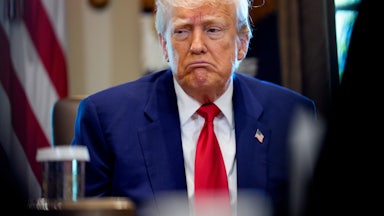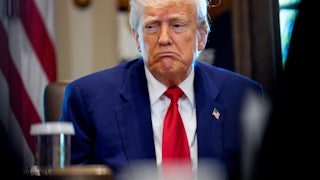All of a sudden, Donald Trump can’t catch a break. November has been a month of humiliations and stinging defeats for a president who, not so long ago, carried himself like an emperor who was universally adored and beyond reproach.
In retrospect, we may look at November 4 as the turning point of Trump’s second term. On Election Day, Democrats romped to victory across the country. Since then, all Trump has done is lose big and melt down. He has lost control of congressional Republicans, been forced to walk back one of his signature issues, and watched his approval rating sink further. Americans increasingly loathe him. Even a Democratic capitulation on the government shutdown did nothing to stop Trump’s slide.
Just 10 months into his second term, Trump has already entered his lame-duck era. And there’s no sign that the dynamic will change for the rest of his presidency.
On Friday, one of this month’s big winners, Zohran Mamdani, the democratic socialist who was just elected mayor of New York City, will visit the White House. Trump will likely use the meeting as an attempt to get his mojo back, perhaps by berating the man he denigrates as a “Communist.” But Mamdani will also offer a sharp contrast to Trump: He’s young, dynamic, and very popular. Trump is none of those things.
It all started on Election Day, which broke the spell that had defined much of the first year of Trump’s presidency. Even though he had won the presidential election by barely more than two million votes, Trump and his allies acted as if they had been granted a divine mandate. They came out of the gate with unprecedented intensity, destroying government departments, launching a fascistic deportation regime, and engaging in corruption so brazen it makes the Gilded Age look tame. The November 4 election results made clear that voters are sick of it. They see Trump as having broken the key promise of his reelection campaign—to lower prices—and desperately want a check on his increasingly lawless administration.
When Democrats ended the government shutdown a week after the election—without securing an extension of the enhanced Affordable Care Act subsidies—it seemed like they were throwing Trump a lifeline. The shutdown had worked for the party politically: Trump’s poll numbers, which had been steadily declining, shot downward, and the Democrats successfully turned the off-year election into a referendum on rising prices and a coming spike in Obamacare premiums. But even if Democrats momentarily relieved the pressure on Trump, it didn’t change his trajectory. He did not regain the momentum that he began the year with, and voters still despise him.
Nowhere is that more evident than in the coming release of the Epstein files, which will almost certainly contain more details about his long friendship with the financier and alleged sex trafficker. Trump ultimately issued an eleventh-hour edict instructing Republicans to vote for their release, but that was only after it was clear they were going to do so anyway and there was nothing he could do to stop them. It’s now clear that, for the first time in his presidency, cracks are showing in his control of the Republican Party. Marjorie Taylor Greene, the conspiracy-addled Georgia representative who had long been one of Trump’s biggest defenders, has embarked on a weeks-long media campaign berating him for his broken promises on the cost-of-living crisis and his failure to release the Epstein files. The lengthy news cycle about those files—and the release of emails in which Epstein described his friendship with Trump—has further damaged his popularity. The full release, if it comes, almost certainly will hurt him further.
As all of this is happening, Trump has also been forced to walk back tariffs on agricultural products—a clear admission that his favorite economic policy is causing prices to rise. By cutting tariffs on coffee, beef, and other consumer goods, Trump is trying to alleviate inflation that he has made significantly worse by embracing a harebrained and antiquated economic scheme. But this likely won’t do enough to bring prices down to consumers’ satisfaction, since the prices were seen as too high even before he embarked on his tariff rampage.
High costs destroyed Biden’s presidency, and they’re destroying Trump’s now too. He seems to understand this, because he’s unraveling. His public statements have become increasingly volatile and erratic. He insulted one female reporter on Air Force One earlier last week, calling her “piggy,” and berated another on Tuesday for having the temerity to ask about the role Saudi Crown Prince Mohammed bin Salman—who was visiting the White House—played in the murder of journalist and American resident Jamal Khashoggi.
On Thursday, he called for several Democrats to be tried for sedition and possibly executed over a video in which they simply called for members of the Armed Forces to follow the laws, and he retweeted a post in which one of his supporters suggested that the Democrats be hanged. It was a display that mirrored the darkest, most deranged moments of Trump’s first term—and one that suggests an ominous path as his presidency continues to self-destruct.
When Mamdani walks into the Oval Office on Friday, he will do so having won an election running on the exact same issue that Trump centered his campaign on a year ago: affordability. Unlike Trump, Mamdani actually wants to do something about it. Their meeting will only reinforce Trump’s failure to control costs—and, I suspect, will yield another Trump meltdown. Not only that, Mamdani will walk into office with something Trump once claimed, but which he has since squandered: a mandate. Most Americans view Trump as a catastrophic failure, and he has not even yet suffered the inevitable blows from next year’s midterm election. This lame duck will only get lamer and lamer.






